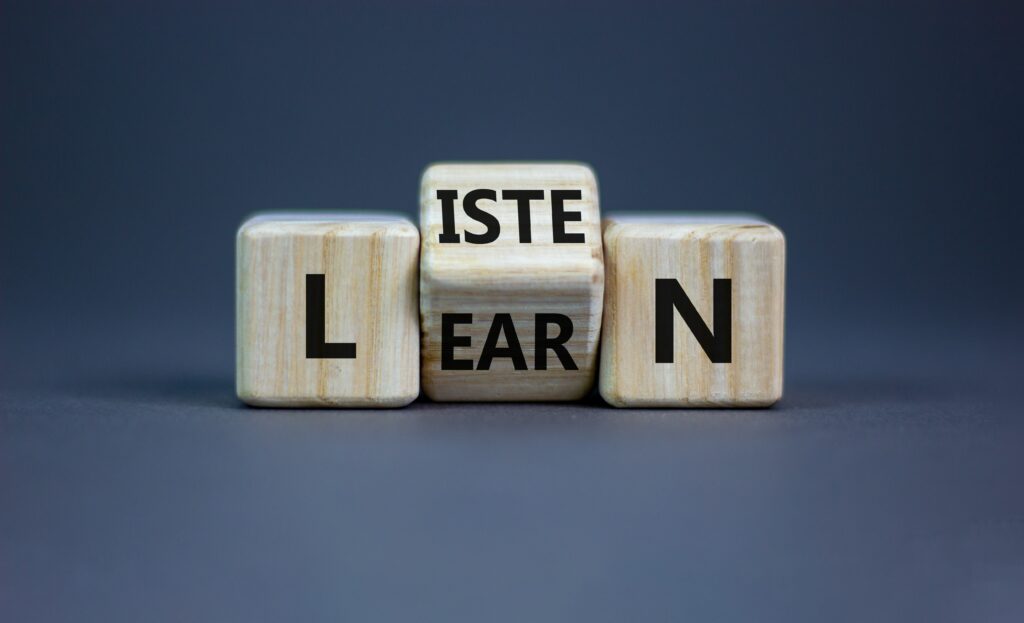In this Article...quick links
To become a great leader you need to be a great communicator. Great communicators possess the ability to engage audiences, implement change, and motivate and inspire those around them. But there is another important quality needed to become an effective communicator and leader. The ability to listen.
Listening is something that many of us take for granted. But merely listening is very different from understanding the nuances of what is actually being said. ‘I hear you’ is quite different from ‘I understand you.’ Listening is an interpersonal skill that is critical to personal and career growth and it’s a skill that needs to be nurtured and developed.
In our business, when we are coaching, we focus on improving participants’ communication and presentation skills in their professional environment. It’s also the focus of most of our blogs, where we dig deeper into specific areas of presenting and communication such as body language, developing gravitas and overcoming stage fright.
But we also highlight in our training programs the importance of being an effective listener. Listening is a critical part of being a good communicator. It’s not simply a one-way street.
Listening, like speaking, is a brain function and as such it is a skill that can be developed. The key is to understand the different listening styles, including your own – and then to learn how to adopt these styles depending on the situation in hand.
The different listening styles
In very broad terms there are four main listening styles:
- Analytical, aiming to solve problems;
- Relational, used to build connections;
- Critical, where the focus is on evaluating the reliability of the information and the speaker; and
- Task, where the emphasis is reaching conclusions as efficiently as possible.
However, these broad groups don’t provide the valuable insights associated with more nuanced listening styles, about which where there is a great deal of research. We’ve reviewed and condensed this research for you and described them in 10 main listening types.
10 listening types everyone should know
We each tend to have one dominant listening style, so look out for one that resonates with you, and also for those that seem to be a less frequent part of your listening repertoire. Only when we understand what we do well, and don’t do well, can we develop our listening ability.
Types of listening styles
1. Passive listening
This is a classic example of listening, but not hearing or understanding. In fact, it’s not far off from ignoring. Many of us spent a great deal of our early years in this mode: at home, at school and perhaps, even in a university lecture hall. Not much is registering and there is very little focus on the speaker or presenter. It’s like having the radio on in the background. We’ve probably all lapsed into this mode occasionally in a social setting, or perhaps even in a business environment. But if you want to progress in your career and you find yourself zoning out at the office on a frequent basis, this style of (not) listening should send alarm bells ringing.
2. Responsive listening
This is similar to passive listening but with the occasional grunt, nod or ‘stock,’ affirmative response like ‘yep,’ or ‘will do.’ This is a very common style of listening between adults and children, and often partners or spouses. It is usually a consequence of over-familiarity, being focussed on something else, or a lack of understanding as to the importance of the topic to the other person. How many times have we heard the phrase ‘Are you listening to me?’ If Responsive listening is a common default for you at work, be aware that this can signal that you’re not engaged. Or worse that you don’t care.
3. Projective listening
This style of listening is when you are listening and taking in a certain amount of information, but because you already have such firm opposing or different views, or resistance to the speaker, you are not allowing anything that is said to influence you. It is common in high-stakes, high-pressure, rules-based or biased situations. If this style resonates with you then be wary, because it’s highly unlikely that your view is always the right or best way to do something. And great leaders and great communicators are, on the whole, those who can objectively assimilate other people’s points of view as part of their evaluation and decision-making process.
4. Connective listening
This is when the focus is placed almost entirely on how the other people in the room (team members, staff, stakeholders) are receiving and reacting to the information that is being shared. As part of this listening style, people may even go as far as to ask questions on behalf of others if they feel that they need further clarification. Their eagerness to connect, with both the speaker (by nodding and agreeing) and the audience, takes precedence over the actual content and if, or how, the content may actually be relevant to them.
5. Active listening
You have probably heard of active listening. This is when we listen intently not just to the words, but also to the intonation of the voice as the words are delivered. We also observe the speaker’s body language, including posture, stance, gestures and movement, as well as their facial expressions. This is so we can ‘hear’ and understand the entire message. active listening, as the name suggests, is ‘active’ because as the listener, we provide active feedback for the speaker. This might be expressed via sincere eye connection with the speaker, as well as smiling, nodding and note-taking. It also includes verbal affirmations e.g. yes, yup, and uh huh.
In a work environment, active listening is extremely important – whether you’re listening to a staff member, your manager, or a client. Be aware though that active listening is devoid of two-way emotional involvement, or empathy. This can be due to the listener being limited by certain policies or maybe they are indifferent to the subject matter. Or, more commonly, the listener lacks the emotional intelligence to engage with the subject and the speaker at this level.
6. Reflective listening
Reflective listener relies on their own personal and professional experiences and knowledge to filter the information they are hearing and then to determine what it actually means for themselves or their team. They will often lean on their own judgement ahead of anyone else’s. This type of listener is often silent for much of a meeting or presentation whilst they make notes and mentally work out how any relevant (and non-relevant) information can be meaningfully applied going forward. Only when they are clear in their own mind will they share their views or conclusions with others.
This type of listener can help a group stay focused and not waste time discussing irrelevant topics. They are also typically good at summarising key points: ‘That works’, ‘We need more data before we give the green light’; ‘That option isn’t suitable’.
The possible downsides to this type of listening are that you may come across as closed and quite blunt. It’s also likely that you’ll appear as though you have a fixed mindset – one that isn’t willing to discuss or debate new ideas or options.
7. Analytical listening
An analytical listening style focuses on the accuracy of the facts and data that are being presented, rather than the credentials and personality of the presenter, even if they’re very senior. This person is often the ‘reality checker’ for the team. In addition, they’ll frequently steer the conversation back to the core issue if the subject goes off track. However, they can be perceived as pessimistic, stubborn, or inflexible. This can be disengaging for other people in a team, especially for the blue-sky thinkers! The danger for this kind of listener is that they may underestimate valuable information and insights simply because it doesn’t fit ‘the box’ and so opportunities can be lost.
8. Conceptual listening
A conceptual listener is the exact opposite of an analytical listener. They like to look at the ‘big picture’ and are valuable in ideas and creative brainstorming environments. They are team players and collaborators with an eye for what ‘could be’. They won’t be worrying about the details, working out the practicalities is someone else’s responsibility. They are strategically focussed and likely to be the ones to excite others with their ideas. One thing to look out for with this listener type is that they can fail to draw any conclusions or next steps as they are simply caught up in the excitement of their ideas.
9. Empathetic listening
This type of listening builds on the skills of the active listener. An empathetic listener gives their full attention to both the information and other communication cues such as body language and facial expressions, tone of voice, pace, flow, and emphasis.
This listener aims to feel and perceive the information from the speaker’s point of view. And like the active listener, they also check in with the speaker to clarify information and provide feedback.
The crucial difference is that they are able to tune in emotionally to what is being communicated. They are able to fully perceive, appreciate, and empathise with how the speaker is feeling and the situation more generally. They may not always agree with the speaker, but the feedback will always be honest, calm, and respectful.
Empathetic listening is a crucial skill to have but be aware that sometimes the conversation can get ‘stuck’ whereby the emotions get in the way of a constructive dialogue that moves the conversation forward to a healthy conclusion.
10. Facilitative listening
Facilitative listening builds from both active and empathetic listening. It requires you to be 100% focussed on the other person and what they’re communicating verbally and non-verbally to identify ways you or the organisation can help them or the situation. It goes way beyond empathetic listening because it requires a capability in the listener to interpret the self-awareness and capability of the speaker. In facilitating some form of a solution, the listener is devoid of selfish or personal motives and is solely focused on the other person’s interests. In many ways, it’s more of an attitude of mind than a style of listening.
Why is it important to be a good listener?
Within any organisation you will come across many of the key listening types we have covered, and they all have something to bring to the party in terms of interpretation, understanding, and collaboration. The collective listening styles of team members (provided the team includes a range of styles) can help senior managers to sift through critical information, draw conclusions and plan for the future. But it is also important to recognise that different situations can require different listening techniques.
It is especially important for a manager to understand how best to listen when interacting with their team members. Here’s an example of how a common conversation at work might go with someone with an Active listening style.
Staff member: “I’m really worried that I won’t get this project finished in time for the meeting.”
Manager: “I know what you mean, I always feel that way myself but somehow, I always manage to get it done. I’m sure you will be OK; you know what you are doing and I trust you.”
In this example, the manager is providing reassurance but is not really understanding the deeper concerns or meeting the needs of his/her staff member.
Now let’s look at how a facilitative listener might handle the same situation.
Staff member: “I’m really worried that I won’t get this project finished in time for the meeting.”
Manager: “I understand how stressful that can be. Would you like me to review with you where you are so far and perhaps I can help you plan out next steps and develop a workable time frame. We can also identify if there is any help one of our team members can provide.”
Learning how to switch styles depending on the situation is not only a great leadership quality, but it can also improve your relationships at both the personal and professional level. Whilst working on your own listening techniques it is also important to understand the listening style of others around you. For example, if you are interacting with an analytical listener, empathetic and facilitative listening may not be particularly helpful or constructive.
6 ways you can improve the way you listen
- First and foremost, you need to identify your default listening style and understand when it may not be appropriate or helpful to the situation. This can often be the case when dealing with people on an individual basis where we need to adopt a more empathetic approach.
- Try to identify upfront what the goal of the conversation is and what style might be best suited. Is the person asking the question looking for a solution, recognition, to improve a connection or simply for honest feedback?
- Don’t try to turn the conversation around so the focus of attention is on you. This can happen when your default listening style is an active one. You think you are helping by sharing a perceived, similar experience, but it’s not actually addressing the needs of the other person. Assess whether the conversation has been productive and if not, ask yourself why.
- If the true meaning of someone’s question is not immediately obvious to you, then revert to one of a great communicator’s most trusted tools. The pause! Take a moment to really think about the question and if there is a more subtle, underlying issue. Pausing also provides the opportunity for the other person to expand or offer more detail.
- Stay focussed on the other person and remember to check in with them. Ask them if it has helped or if they have any other concerns they would like to raise.
- Try not to offer solutions unless this has been specifically requested. Often people are looking for understanding or empathy or simply want to get something ‘off their chest.’
Experimenting with different listening styles can vastly improve and solidify our relationships with our colleagues. It can also increase collaboration, and productivity and forge a deeper understanding with those around us.
If you’d like to improve your presentation skills through training or one-to-one coaching that is tailored to your business, we can help.
For nearly 20 years we have been the Business Presentation Skills Experts, training & coaching thousands of people in global organisations – check out what they say about our programs.
To find out more, click on one of the buttons below:

Belinda is the Co-Founder and Managing Director of SecondNature International. With a determination to drive a paradigm shift in the delivery of presentation skills training both In-Person and Online, she is a strong advocate of a more personal and sustainable presentation skills training methodology.
Belinda believes that people don’t have to change who they are to be the presenter they want to be. So she developed a coaching approach that harnesses people’s unique personality to build their own authentic presentation style and personal brand.
She has helped to transform the presentation skills of people around the world in an A-Z of organisations including Amazon, BBC, Brother, BT, CocaCola, DHL, EE, ESRI, IpsosMORI, Heineken, MARS Inc., Moody’s, Moonpig, Nationwide, Pfizer, Publicis Groupe, Roche, Savills, Triumph and Walmart – to name just a few.





